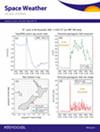Improving Thermospheric Density Predictions in Low-Earth Orbit With Machine Learning
IF 3.7
2区 地球科学
引用次数: 0
Abstract
Thermospheric density is one of the main sources of uncertainty in the estimation of satellites' position and velocity in low-Earth orbit. This has negative consequences in several space domains, including space traffic management, collision avoidance, re-entry predictions, orbital lifetime analysis, and space object cataloging. In this paper, we investigate the prediction accuracy of empirical density models (e.g., NRLMSISE-00 and JB-08) against black-box machine learning (ML) models trained on precise orbit determination-derived thermospheric density data (from CHAMP, GOCE, GRACE, SWARM-A/B satellites). We show that by using the same inputs, the ML models we designed are capable of consistently improving the predictions with respect to state-of-the-art empirical models by reducing the mean absolute percentage error (MAPE) in the thermospheric density estimation from the range of 40%–60% to approximately 20%. As a result of this work, we introduce Karman: an open-source Python software package developed during this study. Karman provides functionalities to ingest and preprocess thermospheric density, solar irradiance, and geomagnetic input data for ML readiness. Additionally, it facilitates developing and training ML models on the aforementioned data and benchmarking their performance at different altitudes, geographic locations, times, and solar activity conditions. Through this contribution, we offer the scientific community a comprehensive tool for comparing and enhancing thermospheric density models using ML techniques.利用机器学习改进低地轨道热层密度预测
热层密度是低地轨道卫星位置和速度估算不确定性的主要来源之一。这给多个空间领域带来了负面影响,包括空间交通管理、避免碰撞、重返预测、轨道寿命分析和空间物体编目。在本文中,我们研究了经验密度模型(如 NRLMSISE-00 和 JB-08)与根据精确轨道测定得出的热层密度数据(来自 CHAMP、GOCE、GRACE、SWARM-A/B 卫星)训练的黑盒机器学习(ML)模型的预测准确性。我们的研究表明,通过使用相同的输入,我们设计的 ML 模型能够持续改进与最先进的经验模型相比的预测结果,将热层密度估计的平均绝对百分比误差(MAPE)从 40%-60% 的范围降低到大约 20%。作为这项工作的成果,我们介绍了 Karman:这是本研究期间开发的一个开源 Python 软件包。Karman 提供了摄取和预处理热层密度、太阳辐照度和地磁输入数据的功能,以便为 ML 做好准备。此外,它还有助于在上述数据上开发和训练 ML 模型,并对其在不同高度、地理位置、时间和太阳活动条件下的性能进行基准测试。通过这一贡献,我们为科学界提供了一个利用 ML 技术比较和增强热层密度模型的综合工具。
本文章由计算机程序翻译,如有差异,请以英文原文为准。
求助全文
约1分钟内获得全文
求助全文

 求助内容:
求助内容: 应助结果提醒方式:
应助结果提醒方式:


